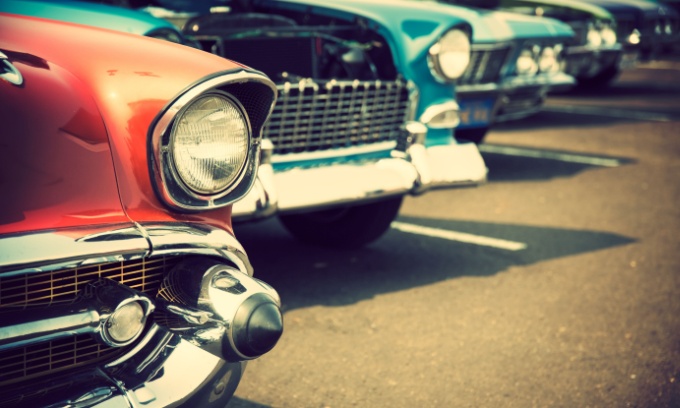KEY POINTS
- Classic car insurance cover often provides features such as agreed car value, laid up cover and limited use options, choice of repairer, multi-vehicle discounts and salvage rights.
- A better deal can often be negotiated on your classic car insurance by comparing different insurance policies and by engaging with classic and vintage car clubs, whose members often provide insight and experience when selecting a policy.
- How much you drive your classic or vintage car often will affect your policy, as some insurers have limitations around how often and how far you can drive.
Car enthusiasts are a passionate bunch, living and breathing anything to do with cars. If you’ve invested in a car (or perhaps a whole car collection), or restored a cherished vehicle, you may find that a regular comprehensive car insurance policy might not be the best fit for protecting your prized vehicle.
What is a classic car?
A classic car is not your everyday vehicle, but one you keep stored away in a garage and only use for special occasions or weekend trips. They also tend to be older cars, though this is not always the case. Some modern cars are now considered classic, such as the Audi R8, due to their rarity, design, historical and cultural significance, and performance capabilities. Modified vehicles, on the other hand, are typically considered to be different, for insurance purposes, to a classic car.
There is no single definition of a classic car that everyone agrees on, so the exact level of cover available comes down to what an insurance provider deems appropriate for the car.
Shannons, part of the Suncorp Group, describes itself as one of the leading insurance providers for motoring enthusiasts in Australia. They provide classic car insurance, as well as vintage and modified car insurance. They also run Shannons club, a forum and a club for car enthusiasts.
Shannons sorts its clients’ cars into three categories:
- Classic (cars older than 30 years).
- Emerging classic (cars made 15 to 30 years ago).
- Modern (cars made in the last 15 years).
Another insurer, NRMA, also provides classic car insurance. They determine their classifications slightly differently:
- Veteran cars (made before 1919).
- Vintage cars (made between 1919 and 1930).
- Classic cars (cars over 15 years in age).
What type of classic car insurance cover is available?
If you plan on taking your classic or vintage car on the road in Australia, then you’ll need to have at least a Compulsory Third Party insurance policy in place (also known as Green Slip insurance in New South Wales). This covers your legal liability if your vehicle causes injury or death in a road accident.
As classic and vintage cars are often more valuable, you might want a more comprehensive car insurance policy. It’s important to note that not every car insurance provider has specific classic car insurance. The type of cover available from each provider will be detailed in their Product Disclosure Statement (PDS). It’s important to read this document carefully to see what is and isn’t covered, if there are specific inclusions and exclusions, and what conditions of use may apply.
A standard insurance policy with add ons may also give you the desired cover. This could come in the form of a third party property damage, third party fire and theft or comprehensive policy. Classic car insurance, on the other hand, often comes with specialised options, such as:
Agreed value of your car — determined between you and your insurer
While market value cover tends to be more common for everyday car insurance policies, classic car insurance policies tend to be for an agreed value determined between the policyholder and the provider. The condition of the vehicle, its rarity and desirability, should all be considered when setting this value amount. Insurers will often ask for photos of the car or for the car itself to be brought in for inspection when negotiating its agreed value.
Limited use options and laid-up cover — how often do you use your car?
Many classic car insurance policies offer reduced premiums while a car is off the road being restored, known as laid up cover. There’s also limited use cover, where if you only drive your car on the weekends or for special occasions, you may be entitled to a reduced premium. Some classic car insurance policies may stipulate that the insured car cannot be your main mode of transport.
Some insurers also offer comprehensive cover specifically for classic or vintage cars used for events such as wedding hire, car club tours, car-enthusiast events and other special occasions. It’s important to inform the insurer on how you plan to use the vehicle at these events.
Choice of repairer — you get to choose
Most classic car insurance policies allow you to choose which repairer or mechanic fixes the damage to your car. This can be helpful as many classic and vintage car owners already know trusted and experienced repairers.
Multi-vehicle discounts — more than one classic car
Classic car enthusiasts often have more than one prized vehicle, with some owners jokingly suggesting that classic cars tend to multiply on their own inside a garage. As a result, some classic car insurance policies include discounts on premiums for each classic car insured under a multi-vehicle policy.
Salvage rights — what happens if the car is written off?
In the unfortunate case that your classic car is written off in a collision, most policies provide a feature called salvage rights. This allows you to keep the unrepaired vehicle at no cost, retaining its functioning parts, which are often costly. It’s worth checking your policy’s PDS to see if your vehicle would fall under this cover, as sometimes vehicle age restrictions apply.
If you’re involved in a road accident, some policies may provide cover for towing, emergency accommodation and transport costs to get you back home if your car isn’t roadworthy. It can also be worth taking out a policy with roadside assistance included, in the unfortunate case that you have a breakdown or are involved in a road accident.
How much does classic car insurance cost?
Classic and vintage car insurance policies often vary in price between providers, because of differing driver situations and needs. The factors that influence how much you pay in premiums can include:
- Your car’s agreed value (determined by you and your insurance provider).
- How regularly you drive your car.
- Where your car is stored at night.
- Your car’s make and model, its age and total kilometres done (obtained from an odometer reading).
- Your personal insurance claim history.
- The state and suburb in which you live in.
- How long you’ve held your licence for.
Related: 10 tips to save money on your car insurance
How can you negotiate a good deal on a classic car insurance policy?
“Good deals are always possible and car club members are often the first to spread the news to each other. The strength of the movement is such that if anyone gets a good or bad deal, then it will be spoken about at club meetings”, said Mr. Neil Athorn of the Australian Historic Motoring Federation.
Mr. Brian Garrett, president of the Classic and Historic Automobile Club of Australia, adds that it’s a good idea to shop around for classic car insurance, even though your options may be limited. “Word of mouth is the main source of information on good deals, followed by a ring around for quotes from different insurance providers.”
How much is your classic car worth?
Popular classic cars may be easier to value than rarer ones. In fact, Enthusiast Motor Insurance, another classic car insurance provider, stresses to all its clients that they do not value cars. Instead, they come to an agreed amount that they and the client are comfortable covering the vehicle for.
Mr. Garrett suggests that “most classic car owners follow values fairly closely. The owner can suggest a value and the insurance company will either accept that value or reject it. Sometimes they may want to see the vehicle before insuring it.”
It’s also important to keep up-to-date records of your classic car to help you when negotiating an agreed value with your insurer. Mr. Graeme Adams, former vice president of the Roadrunner Car Club, agrees. “In all cases when establishing a value, provide photos and documentation of any recent restorations, component reconditioning, and/or new parts, trim, or tyres. It’s also good, when entering into an initial classic car insurance policy, to take the vehicle to the provider’s assessment centre and keep and update records on an annual basis.”
Classic car values often go up with time (not like your typical everyday vehicle where the value goes down), so when renewing a policy it needs to reflect that change in value.
Does how much you drive your classic car affect your policy?
The more your classic car is used and the more kilometres it travels, the greater the potential risk of accidents or damage. There is often a difference in the pricing of a classic car insurance policy for a car driven every day, compared to one used occasionally. Some insurers may even include kilometre limits in their policies and require regular odometer checks to make sure you don’t exceed your allocated distance. There’s also usually a difference in pricing in relation to where a car is stored, the age of the driver/s on the policy and the amount of drivers named on the policy.
You probably bought your classic car because you want to take it out on the open road or show it off at events. Heightened insurance premiums shouldn’t deter you from using your classic car, as occasional trips in your car can help avoid oil leaks and binding clutches and brakes.
Cover image source: topseller/Shutterstock.com








